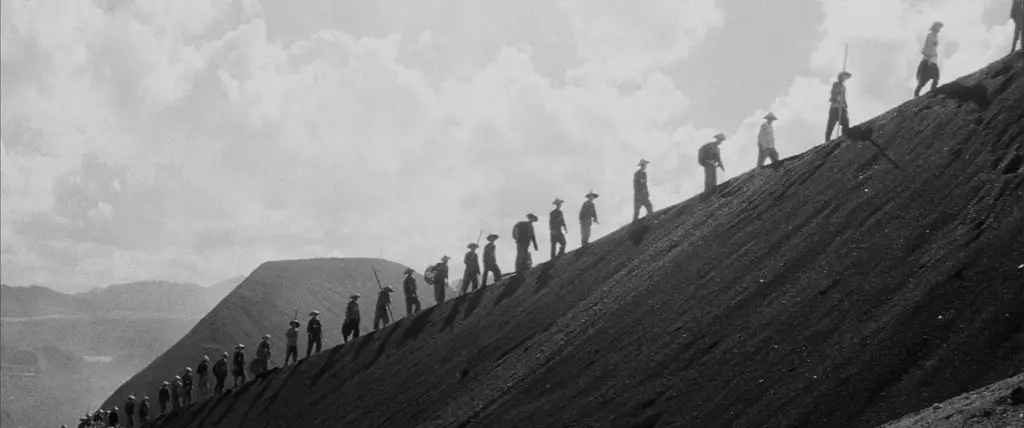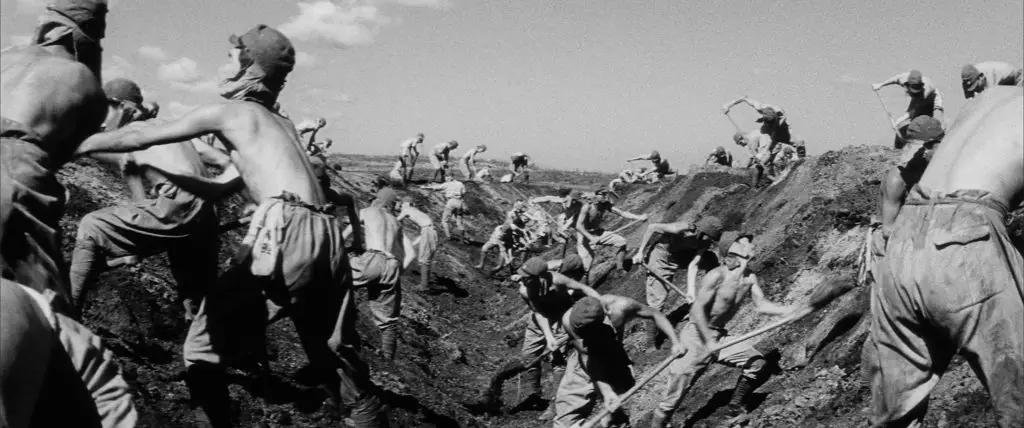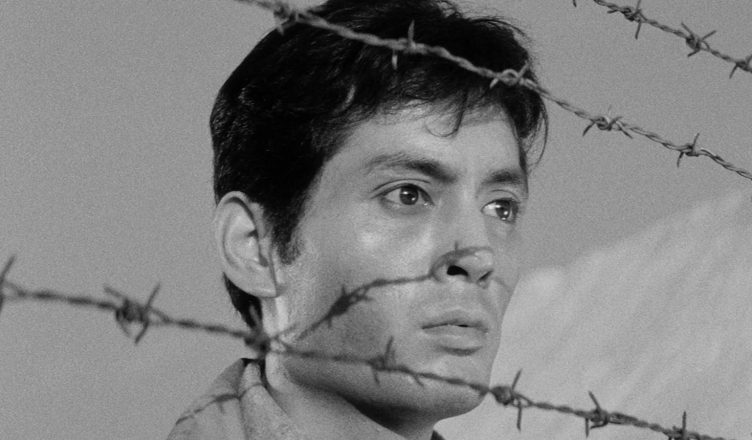The Human Condition (人間の條件, Ningen no jōken)
Director: Masaki Kobayashi
Written by: Masaki Kobayashi, Zenzo Matsuyama, Koichi Inagaki
Year: 1959
Country: Japan
Talking about Rossellini’s Roma Citta Aperta, Godard said, ‘Italy has regained the right of a nation to look itself in the face’. One wonders if the same doesn’t hold true for Japan and The Human Condition.
Despite its indictments of Japanese imperialism, the film received much critical and commercial acclaim back in 1959. In an interview, the lead actor Tatsuya Nakadai (Kaji) recalls how cinema halls would be sold out, even for the film’s marathon viewings. Such wild crowds are surely unusual for a 9-hour film that highlights the masochism of its people. However, the Allied occupation had brought quite a lot of exposure with it and cultural activities had started to thrive. Japan was experiencing a dramatic shift in social and political attitudes; a phenomenon that sits at the heart of Kobayashi’s bleak, discursive rendering of the war. Much like Kaji, Kobayashi was a pacifist and socialist who had to abandon his moral leanings to fight in the Second World War, and most Japanese audiences at the time resonated deeply with that expression.
“During the filming, Kobayashi and Kaji were basically one and the same in my eyes. I think the same could be said of the author (of the source novels), Gomikawa.” –Tatsuya Nakadai
Kaji is a well-intentioned Shakespearean fool, preoccupied with delusions of novelty, constantly ignoring the nagging pragmatism. In the first film, he exudes the characteristic naivety of a youthful reformer; in the second, he exalts the maturity and restraint of a righteous leader; in the third, he retreats inwards, slipping away from the cold indifference of the world. From managing a camp to working in one, the journey is structured to accentuate the ironic touch of tragedy: Here’s an idealistic messiah; here’s a desolate man stripped to his primal needs.
The entire 9-hour work feels like a play perfectly staged in service of one purpose and one purpose only: Open Japanese eyes to their fascist follies. Trauma brings down the resolute and weaklings alike. The reforms that seemed so fervently immediate, the freedom that bellowed restlessly, the gleaming fascist glory at the end of the tunnel, all resemble the blurry portrait of a recently deceased relative; though the portrait itself cannot be helped, one is persuaded to clean the lenses. Nations often correct their course after their pride comes up short, but the ultimate tragedy is that reflection comes afterwards, not before the fact.
It is a rational argument that anti-war films do not have any bearing on the hard facts of written history. But why should they? The promise of art lies not in political or institutional revolution but individual liberation. One should not dwell on one’s misfortunes and wrongdoings but one should not shy away from them either. One of the reasons the film has retained its emotional appeal over the years is that it balances its harsh introspective gaze with ample theatrical resolution.

Aside from its political and social significance for the Japanese, the film serves as a cultural milestone in cinema’s evolution. Cinema has always gone hand in hand with literature but in its infancy, cinema was joined at the hip with theatre. In the silent era, cinema took its cues almost entirely from theatre (pioneers of Italian Neorealism or painters like Bresson were exceptions to the generic mould), then came the Golden Era of Hollywood which emphasized theatrical melodrama over all else, and everything else was pretty much in the same vein. However, the 50s proved to be the last refuge of overtly theatrical productions. Italian Neorealism had already brought a hard-knocks mentality to film, Hollywood was slowly running out of steam, and in the next decade, French New Wave would provide the blueprint for modern cinema, changing the very essence of how films were creatively approached. As such, The Human Condition stands as the last true epic of cinema’s theatrical epoch.
It is ironic that a film primarily concerned with political disillusion can be so deluded about the dynamics of the cultural landscape when especially in Japan, the form was rapidly evolving at the hands of filmmakers like Akira Kurosawa, Yasujiro Ozu, and Kenji Mizoguchi. In the early 50s (sometimes referred to as the Golden Age of Asian Cinema), Ozu was redefining cinematographic simplicity, Mizoguchi was exploring spacial dimensions in ways that would change cinema forever; in the neighbouring country, Satyajit was receiving worldwide acclaim over his serene painterly observations of abject poverty.
So why did Kobayashi stick to the melodramatic ruses of old? The director was used to making films for Shochiku Studio with social messages heavy-handedly driven home using stagey tropes. Shochiku was known for its shinpa melodramas (shinpa is a type of Japanese theatre that made its way into cinema). The Human Condition —his first film for Ninjin Club, an independent film company— seems to be the pivot of his filmmaking career.
“They (Ninjin Club) didn’t want a cinematographer in contract with the Shochiku. They wanted the best cinematographer in Japan, so we asked Miyajima.” –Masaki Kobayashi
Looking at the three films, one finds Kobayashi going through a maturing phase. One of the major reasons for this, of course, is the work of cinematographer Yoshio Miyajima —this was their first collaboration— whose stark chiaroscuro visuals lend much-needed abstraction to the otherwise overbearing work. After The Human Condition, Kobayashi’s films took on a nuanced solemnity, unfazed by trivialities of exposition and helping the audience along. This shift in approach is apparent in his 1962 masterpiece Harakiri which happens to be much shorter, much tighter, and at the same time, offers a lot of breathing space.
“I was basically trained under the Shochiku system which gave the director free reign. But making this film with an independent production company, made me realize for the first time that it’s a collaborative effort involving the whole crew. My films began to change after that realization.” –Masaki Kobayashi

In 1960, Breathless introduced the world to the modern pop film and in the process, freed cinema from the clutches of histrionic theatrics. Though theatre continued to influence the medium, by the early 60s, the cinematograph had started to forge a distinct visual language. The last film of the trilogy came out in 1961 and though a high-end cultural wave was driving cinema towards fresher pastures, the mainstream audiences were still prone to simpler, straight-forward films (they almost always are).
In the context of cultural innovation, one cannot help but scrutinize the Pandora box of the film’s existence. It probes us to be pragmatic in our struggles, to adjust with the changing times, all the while revering the old-school approach that was diminishing at the time. Just like its protagonist, it is naively resolute towards its ambitions even when they cannot be realistically arrived at. Not only does it ignore the faulty merits of its beliefs, but it also goes on to denounce all that is happening around it. Imagine a whining specimen of an ancient species refusing to go extinct even when natural selection commands it so! A futile protest indeed.
“Time is very cruel. Only some films survive.” –Bela Tarr
Upon reflection, it becomes clear how out of place and credulous it really is, just like the Japanese in World War II. One wonders if that contributes to the film’s status as a forgotten artefact. At the precipice of cinema’s timely evolution, Kobayashi’s epic shows us the path not taken, a final word on cinema’s potential as a function of theatre.

References
The Human Condition I: No Greater Love. 1959. [film] Directed by M. Kobayashi. Japan: Ninjin Club, Shochiku Studio.
The Human Condition II: Road to Eternity. 1959. [film] Directed by M. Kobayashi. Japan: Ninjin Club, Shochiku Studio.
The Human Condition III: A Soldier’s Prayer. 1961. [film] Directed by M. Kobayashi. Japan: Ninjin Club, Shochiku Studio.
[Interview by 992719643 767037177 M. Kobayashi]. (2017). Retrieved 2020, from https://www.youtube.com/watch?v=LL3R_K7X3k0
[Interview by 992731221 767043984 T. Nakadai]. (2017). Retrieved 2020, from https://www.youtube.com/watch?v=IUKjJpM9Fgo
Whyte, J., n.d. The Human Condition Blu-Ray Review | Cine Outsider. [online] Cineoutsider.com. Available at: <http://www.cineoutsider.com/reviews/bluray/h/human_condition_br.html> [Accessed 18 October 2020].
- Garam Hawa: On the Precipice of Belonging - November 24, 2020
- Delusion & Disillusion in The Human Condition - October 25, 2020
